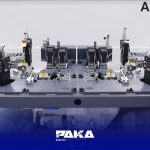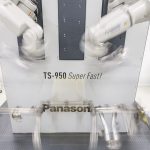Jigs are devices or tools that assist various operations in a company’s production process, such as welding, assembly, machining and quality control.
The incorporation of jigs into robotic systems represents a significant advance in industrial automation, especially in welding processes. This integration combines the precision and efficiency of robots with the stability and consistency of jigs, resulting in faster, more precise and safer operations.
Jigs are commonly used in various industries, such as:
Automotive industry: They are used for welding car components and bodywork, ensuring alignment and precision.
Metalworking industry: Used in the manufacture of metal parts. They ensure that parts are correctly aligned, resulting in precise welds.
Civil industry: They are used in the manufacture of metal structures, such as beams and columns, to ensure structural integrity.
Aeronautical industry: High-precision jigs are used to weld complex components, guaranteeing safety and compliance with strict standards.
In the case of welding jigs, also known as gabarits or fasteners, they are essential devices in the welding process. They hold the parts in a fixed and precise position, allowing for repetitive, high-quality welding.
There are different types of welding jigs and each one is designed for a specific purpose.
Types of welding jigs:
1. Clamping – Used to firmly clamp metal parts during welding.
Applications: They are used for welding metal structures and automotive components.
2. Alignment – Ensures that parts are correctly aligned before and during welding.
Applications: Used in the assembly of precision components, for example in aircraft and car structures.
3. Angle positioning – Allows parts to be welded at specific angles.
Applications: Very commonly used in projects that require welding with non-standard angles, such as metal stairs and complex pipework.
4. Rotation – Allows parts to be rotated during welding, ensuring complete access to the perimeter of the part.
Applications: Used for welding cylinders, tubes and other rotating shapes.
5. Modular – Made up of several adjustable parts that can be configured for different projects.
Applications: They offer versatility when welding parts of different shapes and sizes.
Integrating jigs into the welding process offers numerous benefits, especially when combined with advanced technologies. These benefits range from improvements in product quality to significant increases in process efficiency and safety.
What are the benefits of integrating jigs into the production process?
1. Increased Accuracy and Consistency
– Uniform welds: The jigs ensure that the parts are held in the correct position during welding, resulting in uniform joints.
– Reduced variations: The precision of the jigs minimises variations in the process, ensuring that each piece is welded in the same way.
2. Efficiency and Productivity
– Reduced cycle time: The automation of the jigs allows welding operations to be carried out quickly and repetitively, reducing the time needed to complete each unit.
– Continuous operation: Automated systems can operate 24 hours/day, significantly increasing production.
3. Improving Quality
– Real-time monitoring: Sensors integrated into the jigs continuously monitor the quality of the weld, allowing immediate adjustments and reducing the likelihood of defects.
– Parameter control: Integration with advanced control systems ensures that welding parameters (such as temperature and pressure) are kept within appropriate limits.
4. Security
– Risk reduction: They provide a safer working environment for operators, minimising the need to handle parts during the welding process.
5. Cost reduction
– Less waste: The precision and consistency provided by jigs reduces the amount of material wasted due to defects.
6. Flexibility and Adaptability
– Rapid reconfiguration: Modular jigs and robotic systems can be reconfigured quickly for different tasks, increasing the flexibility of the production line.
– Customized production: The ability to quickly adjust jigs and welding parameters allows customized products to be produced without compromising efficiency.
Jigs are vital tools for guaranteeing the quality of work in any industry that relies on manufacturing and assembly processes. The right choice of jig depends on the specific application, precision requirements and production environment. Integrating jigs into the production process offers a powerful combination of precision, efficiency, safety and flexibility. It not only improves the quality of the end products, but also optimizes production processes, resulting in reduced costs and increased productivity.
Does your company need new production processes to be ready for new challenges or to update an existing model? Speak to us.
We can help you make your industrial process smarter, faster and more efficient.
For more information, please contact: comercial@paka.pt













